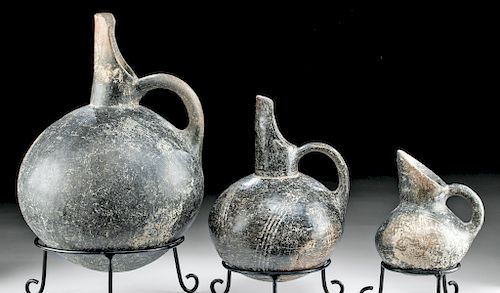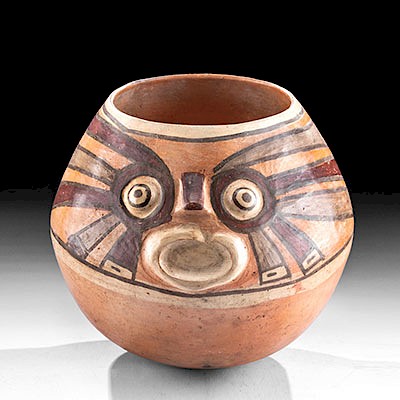Lot of 3 Anatolian Yortan Blackware Pouring Vessels
Lot 51
About Seller
Artemis Fine Arts
686 S Taylor Ave, Ste 106
Louisville, CO 80027
United States
Selling antiquities, ancient and ethnographic art online since 1993, Artemis Gallery specializes in Classical Antiquities (Egyptian, Greek, Roman, Near Eastern), Asian, Pre-Columbian, African / Tribal / Oceanographic art. Our extensive inventory includes pottery, stone, metal, wood, glass and textil...Read more
Categories
Estimate:
$2,000 - $3,000
Absentee vs Live bid
Two ways to bid:
- Leave a max absentee bid and the platform will bid on your behalf up to your maximum bid during the live auction.
- Bid live during the auction and your bids will be submitted real-time to the auctioneer.
Bid Increments
| Price | Bid Increment |
|---|---|
| $0 | $25 |
| $300 | $50 |
| $1,000 | $100 |
| $2,000 | $250 |
| $5,000 | $500 |
| $10,000 | $1,000 |
| $20,000 | $2,500 |
| $50,000 | $5,000 |
| $100,000 | $10,000 |
| $200,000 | $20,000 |
About Auction
By Artemis Fine Arts
Dec 5, 2019
Set Reminder
2019-12-05 10:00:00
2019-12-05 10:00:00
America/New_York
Bidsquare
Bidsquare : Ancient / Ethnographic - Holiday Edition
https://www.bidsquare.com/auctions/artemis-gallery/ancient-ethnographic---holiday-edition-4710
What to give this holiday season? Ancient & Ethnographic Art of course! Our special Holiday auction features hundreds of unique finds from all over the world. Artemis Fine Arts info@artemisfinearts.com
What to give this holiday season? Ancient & Ethnographic Art of course! Our special Holiday auction features hundreds of unique finds from all over the world. Artemis Fine Arts info@artemisfinearts.com
- Lot Description
Ancient Asia Minor, Western Anatolia, Yortan culture, Early Bronze Age II, ca. 2700 to 2400 BCE. A fine gathering of three wheel-thrown blackware pottery vessels with highly burnished surfaces and incised decorations. Each vessel has a round but stable base, a spherical body with a sloped shoulder, and a thick handle, with the smaller vessel bearing a rounded spout with a slanted lip, and the two larger vessels with projecting cylindrical spouts with rounded lips. The exterior of each body displays registers of lightly incised zigzagging motifs that stretch from just above the base to just below the spout. Size of largest: 9.4" W x 12.75" H (23.9 cm x 32.4 cm); 14.75" H (37.5 cm) on included custom stand.
Ancient Western Anatolia is famous for a number of large ruins, most notably Troy (Hisarlik), but many mysteries remain. The Yortan culture is known through a burial site in the valley of Bakir Cai that has not been well-studied. Adults and children are buried, crouched, in large terracotta storage containers; around them were placed a great deal of pottery in the form of jugs, jars, and occasionally bowls, much of it blackware just like these examples.
For a stylistically similar example of the smaller vessel, please see The Metropolitan Museum of Art, accession number 62.114.2; for an example similar to the larger vessels, see accession number 62.153.
Provenance: private Virginia, USA collection
All items legal to buy/sell under U.S. Statute covering cultural patrimony Code 2600, CHAPTER 14, and are guaranteed to be as described or your money back.
A Certificate of Authenticity will accompany all winning bids.
We ship worldwide and handle all shipping in-house for your convenience.
#150320Medium-sized vessel has repairs to spout and handle, with stabilization to one fissure along lower body, and chipping and light adhesive residue along break lines; smallest and largest vessels are intact and very good. All three vessels have abrasions and nicks to spouts, handles, bodies, and bases, with light softening to incised motifs, fading to areas of original black coloration, and encrustations. Great earthen deposits and traces of original black color throughout.Condition
- Shipping Info
-
All shipping is handled in-house for your convenience. Your invoice from Artemis Gallery will include shipping calculation instructions. If in doubt, please inquire BEFORE bidding for estimated shipping costs for individual items.
-
- Buyer's Premium



 EUR
EUR CAD
CAD AUD
AUD GBP
GBP MXN
MXN HKD
HKD CNY
CNY MYR
MYR SEK
SEK SGD
SGD CHF
CHF THB
THB














